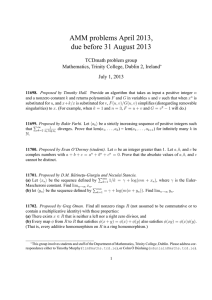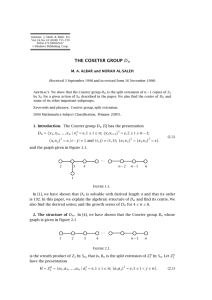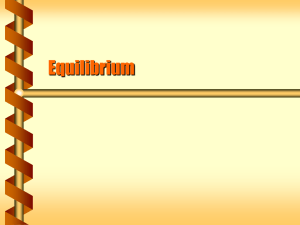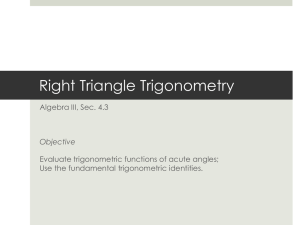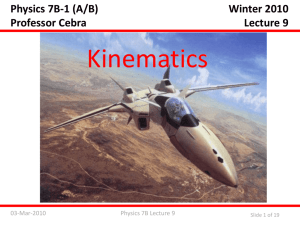Internat. J. Math. & Math. Sci. S0161171200004439 © Hindawi Publishing Corp.
advertisement
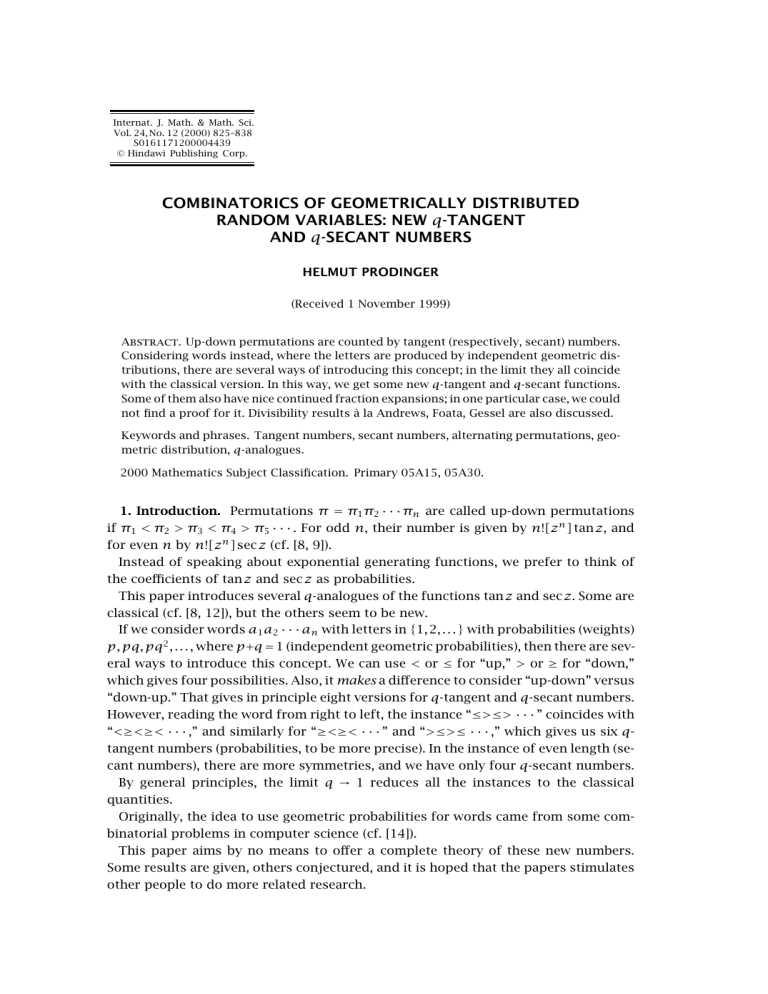
Internat. J. Math. & Math. Sci.
Vol. 24, No. 12 (2000) 825–838
S0161171200004439
© Hindawi Publishing Corp.
COMBINATORICS OF GEOMETRICALLY DISTRIBUTED
RANDOM VARIABLES: NEW q-TANGENT
AND q-SECANT NUMBERS
HELMUT PRODINGER
(Received 1 November 1999)
Abstract. Up-down permutations are counted by tangent (respectively, secant) numbers.
Considering words instead, where the letters are produced by independent geometric distributions, there are several ways of introducing this concept; in the limit they all coincide
with the classical version. In this way, we get some new q-tangent and q-secant functions.
Some of them also have nice continued fraction expansions; in one particular case, we could
not find a proof for it. Divisibility results à la Andrews, Foata, Gessel are also discussed.
Keywords and phrases. Tangent numbers, secant numbers, alternating permutations, geometric distribution, q-analogues.
2000 Mathematics Subject Classification. Primary 05A15, 05A30.
1. Introduction. Permutations π = π1 π2 · · · πn are called up-down permutations
if π1 < π2 > π3 < π4 > π5 · · · . For odd n, their number is given by n![zn ] tan z, and
for even n by n![zn ] sec z (cf. [8, 9]).
Instead of speaking about exponential generating functions, we prefer to think of
the coefficients of tan z and sec z as probabilities.
This paper introduces several q-analogues of the functions tan z and sec z. Some are
classical (cf. [8, 12]), but the others seem to be new.
If we consider words a1 a2 · · · an with letters in {1, 2, . . . } with probabilities (weights)
p, pq, pq2 , . . . , where p+q = 1 (independent geometric probabilities), then there are several ways to introduce this concept. We can use < or ≤ for “up,” > or ≥ for “down,”
which gives four possibilities. Also, it makes a difference to consider “up-down” versus
“down-up.” That gives in principle eight versions for q-tangent and q-secant numbers.
However, reading the word from right to left, the instance “≤>≤> · · · ” coincides with
“<≥<≥< · · · ,” and similarly for “≥<≥< · · · ” and “>≤>≤ · · · ,” which gives us six qtangent numbers (probabilities, to be more precise). In the instance of even length (secant numbers), there are more symmetries, and we have only four q-secant numbers.
By general principles, the limit q → 1 reduces all the instances to the classical
quantities.
Originally, the idea to use geometric probabilities for words came from some combinatorial problems in computer science (cf. [14]).
This paper aims by no means to offer a complete theory of these new numbers.
Some results are given, others conjectured, and it is hoped that the papers stimulates
other people to do more related research.
826
HELMUT PRODINGER
A few definitions from q-analysis are needed; see [1, 2]:
[n]q : =
1 − qn
,
1−q
[n]q ! := [1]q [2]q · · · [n]q ,
(x; q)n : = (1 − x)(1 − xq) 1 − xq2 · · · 1 − xqn−1 .
(1.1)
2. Recursions. The classical book [8] offers a general framework to deal with words
and pattern (“pattern algebra”). However, we have decided to use a different approach
that works particularly well in the present context, and is completely elementary. It
is called the “adding a new slice” technique. In doing so, recursions are obtained; by
iterating them, the generating functions of interest come out almost effortlessly.
We introduce the functions
Tn≤≥ (u),
(2.1)
where the coefficient of ui in it is the probability that a word of length n satisfies the
≤≥≤≥ · · · condition and ends with the letter i. Also, we define
τn≤≥ = Tn≤≥ (1),
which drops the technical condition about the last letter.
Furthermore, we introduce the generating functions
F ≤≥ (z, u) =
Tn≤≥ (u)zn ,
f ≤≥ (z) = F ≤≥ (z, 1).
(2.2)
(2.3)
n≥0
Quantities like F ≤> (z, u) etc. are defined in an obvious way.
For the instance of secant numbers, similar quantities will be defined, but the letters
S, σ , G, g are used instead of T , τ, F , f .
Obviously, there are only nonzero contributions for odd n in the tangent case and
for even n in the secant case.
The reason to operate with a variable u that controls the last letter is the technique
of “adding a new slice,” that was applied with success in [6] and, more recently, in [13].
∇
Theorem 2.1. The functions T2n+1
(u) satisfy the following recurrences:
≥≤
T2n+1
(u) =
T1≥≤ (u) =
≥<
(u) =
T2n+1
T1≥< (u) =
><
T2n+1
(u) =
T1>< (u) =
≤≥
(u) =
T2n+1
T1≤≥ (u) =
p2 u
p2 u
T ≥≤ (1) −
T ≥≤ q2 u ,
(1 − qu) 1 − q2 u 2n−1
(1 − qu) 1 − q2 u 2n−1
pu
,
1 − qu
2 p 2 qu2
p 2 qu2
≥<
≥<
T2n−1
T2n−1
(1) −
q u ,
2
2
(1 − qu) 1 − q u
(1 − qu) 1 − q u
pu
,
1 − qu
p 2 qu2
p2 u
><
T2n−1
T >< q2 u ,
(1) −
2
(1 − qu) 1 − q u
q(1 − qu) 1 − q2 u 2n−1
pu
,
1 − qu
pu
p2 u
≤≥
T ≤≥ q2 u ,
(q) −
T2n−1
q(1 − qu)
q(1 − qu) 1 − q2 u 2n−1
pu
,
1 − qu
(2.4)
(2.5)
(2.6)
(2.7)
q-TANGENT AND q-SECANT NUMBERS
827
pu
p2
≤>
T ≤> q2 u ,
T2n−1
(q) − 2
q(1 − qu)
q (1 − qu) 1 − q2 u 2n−1
pu
T1≤> (u) =
,
1 − qu
(2.8)
pu
p2 u
<>
T <> q2 u ,
T2n−1
(q) −
1 − qu
(1 − qu) 1 − q2 u 2n−1
pu
T1<> (u) =
.
1 − qu
(2.9)
≤>
T2n+1
(u) =
<>
(u) =
T2n+1
Proof. Since the technique is the same for all the instances, it is enough to discuss,
for example, the “≥≤” case. Adding a new slice means adding a pair (k, j) with 1 ≤
k ≤ i, j ≥ k, replacing ui by 1 and providing the factor uj . But
i
k=1
pqk−1
pqj−1 uj =
j≥k
p2 u
p2 u
−
q2 u i ,
2
2
(1 − qu) 1 − q u
(1 − qu) 1 − q u
(2.10)
which explains the recursion. The starting value is just
pqj−1 uj =
j≥1
pu
.
1 − qu
(2.11)
(Readers who feel uncomfortable with this technique can write down a recursion for
P2n+1,j , the probability that a down-up composition of length 2n+1 ends with j, namely,
j−1
P2n+1,j = pqj−1 1 − qj
P2n−1,j −
pqj−k−1 1 − qj−k q2k P 2n−1,k ,
j≥1
(2.12)
k=1
and translate it afterwards into (2.4).)
∇
Theorem 2.2. The numbers τ2n+1
have the generating functions f ∇ (z) = tanq (z)
= sinq (z)/ cosq (z):
(−1)n z2n+1 /[2n + 1]q ! qn(n+1)
,
n 2n /[2n] ! q n(n−1)
q
n≥0 (−1) z
n 2n+1
/[2n + 1]q !
n≥0 (−1) z
,
f ≥< (z) =
n 2n /[2n] !
q
n≥0 (−1) z
n≥0
f ≥≤ (z) =
f
(z) =
2
(−1)n z2n+1 /[2n + 1]q ! qn
2
,
n 2n /[2n] ! q n
q
n≥0 (−1) z
><
n≥0
2
n 2n+1
/[2n + 1]q ! qn
n≥0 (−1) z
,
f (z) = n 2n /[2n] ! q n(n−1)
q
n≥0 (−1) z
n 2n+1
/[2n + 1]q !
n≥0 (−1) z
,
f ≤> (z) =
n 2n /[2n] !
q
n≥0 (−1) z
n 2n+1
/[2n + 1]q ! qn(n+1)
n≥0 (−1) z
2
.
f <> (z) =
n 2n /[2n] ! q n
q
n≥0 (−1) z
≤≥
(2.13)
828
HELMUT PRODINGER
Proof. The proofs of the first three relations are very similar, and we only sketch
the first instance. Summing up we find
F ≥≤ (z, u) =
puz
p 2 uz2
p 2 uz2
F ≥≤ (z, 1) −
F ≥≤ z, q2 u .
+
2
2
1 − qu (1 − qu) 1 − q u
(1 − qu) 1 − q u
(2.14)
Iterating that we find for f (z) = f ≥≤ (z):
f (z) =
p2 z2
p 2 q2 z3
pz
f (z) −
+
2
1 − q (1 − q) 1 − q
(1 − q) 1 − q2 1 − q3
−
p 4 q2 z4
f (z) + · · ·
(1 − q) 1 − q2 1 − q3 1 − q4
(2.15)
from which the announced formula follows by solving for f (z).
∇∆
(q). Again, one case is disThe three others are trickier, because of a term T2n−1
cussed. Observe that
≤≥
≤≥
T2n−1
(q) = q−1 S2n
(1),
(2.16)
because one more “up” step should replace ui by k≥i pqk−1 = qi−1 . Now the gener≤≥
ating function g ≤≥ (z) of the quantities S2n
(1) (upcoming) is obtained independently,
whence we get
F ≤≥ (z, u) =
puz
p 2 uz2
F ≤≥ z, q2 u .
g ≤≥ (z) −
q2 (1 − qz)
q(1 − qu) 1 − q2 u
(2.17)
Now iteration as usual derives the desired result.
∇
Theorem 2.3. The functions S2n
(u) satisfy the following recurrences:
≤≥
(u) =
S2n+2
S2≤≥ (u) =
≤>
S2n+2
(u) =
S2≤> (u)
p2 u
p2 u
≤≥
S2n
S ≤≥ q2 u ,
(1)
−
(1 − qu) 1 − q2 u
(1 − qu) 1 − q2 u 2n
p2 u
,
(1 − qu) 1 − q2 u
2 p2 u
p2
≤>
≤>
S2n
S2n
(1) − 2
q u ,
2
2
(1 − qu) 1 − q u
q (1 − qu) 1 − q u
p2 u
,
=
(1 − qu) 1 − q2 u
<≥
S2n+2
(u) =
S2<≥ (u) =
p 2 qu2
p 2 qu2
<≥
S2n
S <≥ q2 u ,
(1)
−
(1 − qu) 1 − q2 u
(1 − qu) 1 − q2 u 2n
p 2 qu2
,
(1 − qu) 1 − q2 u
(2.18)
(2.19)
(2.20)
q-TANGENT AND q-SECANT NUMBERS
<>
S2n+2
(u) =
S2<> (u) =
p 2 qu2
p2 u
<>
S2n
S <> q2 u ,
(1)
−
(1 − qu) 1 − q2 u
q(1 − qu) 1 − q2 u 2n
p 2 qu2
.
(1 − qu) 1 − q2 u
829
(2.21)
Proof. The proof works as in the easy cases of the tangent recursions and is
omitted. For the starting value, the first pair of numbers must be considered.
∇
Theorem 2.4. The numbers σ2n
have the generating functions g ∇ (z) = 1/cosq (z):
1
,
(−1)n z2n /[2n]q ! qn(n−1)
g ≤≥ (z) = g ≤> (z) = n≥0
1
,
(−1)n z2n /[2n]q !
n≥0
<≥
1
,
(−1)n z2n /[2n]q ! qn(2n−1)
(z) = g <> (z) = g
n≥0
n≥0
(2.22)
1
.
(−1)n z2n /[2n]q ! qn2
Proof. The proofs are quite similar as before; however, iteration must be done for
the function G∇∆ (z, u) − 1, and 1 must be added at the end.
3. Jackson’s q-sine and q-cosine functions. In this section, we are considering a
general class of q-sine and q-cosine functions and sort out those that satisfy a natural condition. This condition is even more natural, as all the previously encountered
q-sine and q-cosine functions satisfy them.
Jackson in [12] has introduced the functions
sinq (z) =
(−1)n z2n+1
,
[2n + 1]q !
n≥0
cosq (z) =
(−1)n z2n
[2n]q !
n≥0
(3.1)
and proved the relation
sinq (z) sin1/q (z) + cosq (z) cos1/q (z) = 1.
(3.2)
Since we have here several q-sine and q-cosine functions, we call them a q-sine-cosine
pair, if relation (3.2) holds.
Theorem 3.1. For the functions
sinq (z) :=
(−1)n z2n+1
2
qAn +Bn ,
[2n
+
1]
!
q
n≥0
cosq (z) :=
(−1)n z2n
2
qCn +Dn
[2n]
!
q
n≥0
exactly the twelve pairs in Table 3.1 are q-sine-cosine pairs:
(3.3)
830
HELMUT PRODINGER
Table 3.1.
A
B
C
0
0
0
D
2
1
0
0
0
0
2
−1
2
1
2
−1
0
1
0
1
2
0
0
1
1
0
1
0
1
1
1
0
0
1
2
−2
2
0
2
−2
1
0
1
−1
1
1
1
−1
0
Proof. The desired relation gives more and more restrictions for the (complex)
numbers A, B, C, D when we look at the coefficients of z2n for n = 0, 1, 2, . . . . By a
tedious search that will not be reported here we find these twelve possibilities, and
all others can be excluded. The proof that this indeed works is very similar for all of
them, so we give just one, namely the instance (1, 0, 1, 0).
Note the following expansions:
sin1/q z =
(−1)n z2n+1 2n+1 −n2
q 2
,
[2n + 1]q !
n≥0
cos1/q z =
(−1)n z2n 2n −n2
q 2
.
[2n]q !
n≥0
So we must prove that, for n ≥ 1,
n
n−1
2k −k2 +(n−k)2
2k+1
2
2
2n
2n
q 2
q 2 −k +(n−k−1)
=
k=0 2k q
k=0 2k + 1 q
or, reversing the order of summation in the second sum,
n
n−1
2n
2n
2 −k−2nk
2k
q
q2k2 +k−n−2nk .
=
k=0 2k q
k=0 2k + 1 q
(3.4)
(3.5)
(3.6)
We rewrite this again as
2n
k
k
2n q−nk+ 2 =
q−nk+ 2 .
k q
k q
k even
k odd
Therefore, we have to prove that
2n
2n
k=0
k
q
(−1)k q
(3.7)
−nk+ k
2
= 0.
(3.8)
831
q-TANGENT AND q-SECANT NUMBERS
We use the formula (10.0.9) in [2], see also [1],
n−1
n
k
n zk q 2 =
1 + qj z .
k=0 k q
j=0
(3.9)
The desired result now follows by replacing n by 2n and plugging in z = −q−n .
Theorem 3.2. The six tanq (z) functions in Theorem 2.2 all involve q-sine-cosine
pairs.
Remark 3.3. Replacing q by 1/q in the q-sine-cosine pairs and rewriting everything
again in the q-notation means replacing the vector (A, B, C, D) of exponents by (2−A,
1 − B, 2 − C, −1 − D). This will be called “duality.”
Table 3.2.
A
B
C
D
A
B
C
D
0
0
0
0
2
1
2
−1
2
1
0
0
0
0
2
−1
0
1
0
1
2
0
2
−2
2
0
0
1
0
1
2
−2
1
0
1
0
1
1
1
−1
1
1
1
0
1
0
1
−1
This reduces the twelve pairs to six pairs.
4. Continued fractions. Experimenting with Maple, it was found that some of the
twelve tangent functions have nice continued fraction expansions. Some could be
proved, others not (yet).
A lot of work still needs to be done concerning a combinatorial theory of these
continued fractions, perhaps in the style of [5].
Theorem 4.1. For (A, B, C, D) = (0, 0, 0, 0) and (A, B, C, D) = (2, 1, 2, −1) we have
z
tanq (z) =
[1]q
.
z2
q−0 −
(4.1)
z2
[3]q q−1 −
z2
[5]q q−2 −
[7]q q−3 −
z2
..
.
The two tangent functions coincide, which is classical, since Jackson [12] has shown that
for his functions
sinq z cos1/q z − sin1/q z cosq z = 0
holds.
(4.2)
832
HELMUT PRODINGER
Proof. For the proof by induction we must do the following: set an = [2n − 1]q q1−n
and
pn (z) = an pn−1 (z) − z2 pn−2 (z),
2
qn (z) = an qn−1 (z) − z qn−2 (z),
p0 (z) = 0,
p1 (z) = z,
q0 (z) = 1,
q1 (z) = a1 .
(4.3)
We must show that
zk pn (z) cosq z − qn (z) sinq z = 0
for k ≤ 2n.
(4.4)
Now look at
zk
an pn−1 (z) − z2 pn−2 (z) cosq z − an qn−1 (z) − z2 qn−2 (z) sinq z .
(4.5)
By the induction hypothesis we only have to show that
z2n−1 pn (z) cosq z − qn (z) sinq z = 0.
(4.6)
However, we can easily show by induction that
n
[2n − 2k − 1]q !qk(2k+1)− 2
(−1)
pn (z) = z
,
n−1−2k [n − 2k − 1]q ![2k + 1]q ! i=1
1 + qi
k
n
[2n − 2k]q !qk(2k−1)− 2
2k
k
qn (z) = z (−1)
,
n−2k [n − 2k]q ![2k]q ! i=1 1 + qi
k
2k+1
k
(4.7)
holds (the hard part is to find these formulae). We have to prove that
z2k+1 pn (z) z2n−2k−2 cosq z =
k≥0
z2k qn (z) z2n−2k−1 sinq z
(4.8)
k≥0
or
(n−1)/2
k=0
[2n − 2k − 1]q !qk(2k+1)
n−1−2k [n − 2k − 1]q ![2k + 1]q ! i=1
1 + qi [2n − 2k − 2]q !
=
n/2
k=0
[2n − 2k]q !qk(2k−1)
.
n−2k [n − 2k]q ![2k]q ! i=1 1 + qi [2n − 2k − 1]q !
(4.9)
Thus we must prove
(n−1)/2
k=0
1 − q2n−2k−1 qk(2k+1)
n−1−2k 1 + qi
i=1
[n − 2k − 1]q ![2k + 1]q !
=
n/2
k=0
1 − q2n−2k qk(2k−1)
n−2k [n − 2k]q ![2k]q ! i=1 1 + qi
(4.10)
or
n
k=0
1 − q2n−k q
[n − k]q ![k]q !
k
2
(−1)k
n−k i
i=1 1 + q
= 0,
(4.11)
833
q-TANGENT AND q-SECANT NUMBERS
or
n
1
1 − q2n−k q
2 ; q2
(q;
q)
q
k
n−k
k=0
Now
n
1
q
2 ; q2
(q;
q)
q
k
n−k
k=0
k
2
k
2
(−1)k = 0.
(4.12)
k
2
(−1)k zk zk
2
(q; q)k
q ; q2 k
k≥0
k≥0
k
zn
k≥0 1 − zq
= zn
=
1 − zq2k+1
2k
k≥0 1 − zq
k≥0
n
2
2 2
n
(−1)n (−1)n qn
q
q
= 2 2 .
1 − zq2k =
= qn zn
2
2
q ;q n
q ;q n
k≥0
(−1)k = zn
q
(4.13)
Similarly,
n
q2n−k
q
(q; q)k q2 ; q2 n−k
k=0
q
k
2 (−1)k = q 2n z n
k
2
(−1)k (z/q)k zk
2
(q; q)k
q ; q2 k
k≥0
k≥0
q2n [zn ] k≥0 1 − zqk−1
= q2n zn
=
1 − zq2k−1
2k
k≥0 1 − zq
k≥0
n
2
2
n
q q 2 (−1)n (−1)n qn
= 2 2 .
1−zq2k =
= q2n q−n zn
2
2
q ;q n
q ;q n
k≥0
(4.14)
This finishes the proof.
The continued fraction for (2, 1, 2, −1) follows by replacing q by 1/q.
Theorem 4.2. For (A, B, C, D) = (0, 1, 0, 1) we have
z
tanq (z) =
[1]q
.
z2
q−0 −
(4.15)
z2
[3]q q−2 −
[5]q q−2 −
z2
[7]q q−4 −
z2
..
.
The negative powers of q go like 0, 2, 2, 4, 4, 6, 6, 8, 8, . . . .
Proof. The proof follows the same lines; this time the polynomials (continuants)
are
n
[2n − 2k − 1]q !q2k(k+1)− 2 −[n/2]
2k+1
k
pn (z) = z
(−1)
,
n−1−2k [n − 2k − 1]q ![2k + 1]q ! i=1
1 + qi
k
n
(4.16)
2k2 − 2 −[n/2]
[2n
−
2k]
!q
q
qn (z) = z2k (−1)k
.
n−2k [n − 2k]q ![2k]q ! i=1 1 + qi
k
834
HELMUT PRODINGER
Hence we have to prove that
[(n−1)/2]
k=0
1 − q2n−2k−1 q2k(k+1)−k
[n − 2k − 1]q ![2k + 1]q !
n−1−2k 1 + qi
i=1
=
[n/2]
k=0
2
1 − q2n−2k q2k −k
;
n−2k [n − 2k]q ![2k]q ! i=1 1 + qi
(4.17)
from here on we can use the previous proof.
An alternative proof is by noting that
1
(z) = √ tan(0,0,0,0)
z q
tan(0,1,0,1)
q
q
q
(4.18)
and using the previous result.
Theorem 4.3. For (A, B, C, D) = (2, 0, 2, −2) we have
z
tanq (z) =
.
z2
[1]q q−0 −
(4.19)
z2
[3]q q−0 −
z2
[5]q q−2 −
[7]q q−2 −
z2
..
.
The negative powers of q go like 0, 0, 2, 2, 4, 4, 6, 6, 8, 8, . . . .
Proof. This follows from the previous theorem by replacing q by 1/q.
Conjecture 4.4. For (A, B, C, D) = (1, 0, 1, 0) we have
z
tanq (z) =
[1]q
.
z2
q0 −
(4.20)
z2
[3]q q−2 −
[5]q q1 −
z2
[7]q q−9 −
z2
..
.
The positive powers of q go like 0, 1, 6, 15, . . . (k(2k − 1)).
The negative powers of q go like 2, 9, 20, 35, . . . ((k + 1)(2k − 1)).
Comment. It might be useful to rewrite the continued fraction as
z
(4.21)
z2 b1
1−
z2 b2
1−
1−
z2 b3
1−
z2 b4
..
.
835
q-TANGENT AND q-SECANT NUMBERS
with
1
k
q−k+(−1) (2k−1)
[k]q [k + 1]q
(−1)k −3k+1 1
1 −3k+1 q
q
=
1 + q4k−2 −
1 − q4k−2 .
[k]q [k + 1]q 2
2
bk =
(4.22)
The recursions for the continuants are now
pn (z) = pn−1 (z) − bn−1 z2 pn−2 (z),
2
qn (z) = qn−1 (z) − bn−1 z qn−2 (z),
p0 (z) = 0,
p1 (z) = z,
q0 (z) = 1,
q1 (z) = 1.
(4.23)
Unfortunately, even with this form, I am currently unable to guess the coefficients of
these polynomials, whence I must leave this expansion as an open problem.
Note. Added in proof (September 2000): Markus Fulmek has established that
recently.
Conjecture 4.5. For (A, B, C, D) = (1, 1, 1, −1) we have
z
tanq (z) =
[1]q
.
z2
q−0 −
(4.24)
z2
[3]q q0 −
z2
[5]q q−5 −
[7]q q3 −
z2
..
.
The positive powers of q go like 0, 3, 10, 21, . . . ((k − 1)(2k − 1)).
The negative powers of q go like 0, 5, 14, 27, . . . ((k − 1)(2k + 1)).
Comment. This would be a corollary of the previous expansion.
Remark 4.6. Normally, as for example in [5, 10], the continued fraction expansions
of the ordinary generating function of the tangent and secant numbers are considered,
whereas we stick here to the exponential (or probability) generating functions.
5. Divisibility
Theorem 5.1. The coefficient
[2n + 1]q z2n+1 tanq (z)
(5.1)
(1 + q) 1 + q2 · · · 1 + qn
(5.2)
is divisible by
for the vectors of exponents (0, 0, 0, 0), (2, 1, 2, −1), (0, 1, 0, 1), (2, 0, 2, −2), (1, 0, 1, 0),
and (1, 1, 1, −1).
Proof. The proof of [4] covers the first four instances, since we note that
1
tan(0,1,0,1)
(z) = √ tan(0,0,0,0)
z q .
q
q
q
(5.3)
836
HELMUT PRODINGER
The only open case is thus (1, 0, 1, 0), as the remaining one would follow from duality.
Thus, let us now consider
sinq z =
(−1)n z2n+1 2
qn ,
[2n + 1]q !
n≥0
cosq z =
(−1)n z2n 2
qn ,
[2n]q !
n≥0
(5.4)
and tanq z = sinq z/ cosq z.
We need the following computation that is akin to the one in Theorem 3.1,
2
n
(−1)k qk(k+1) (−1)n−k q(n−k)
[2n − 2k]q !
[2k + 1]q !
k=0
2
n
qn (−1)n 2n + 1 2k2 +k−2nk
=
q
[2n + 1]q ! k=0 2k + 1
z2n+1 sin1/q z cosq z =
q
k −nk
qn(n+1) (−1)n 2n + 1
=
q 2
[2n + 1]q ! k odd
k
qn(n+1) (−1)n 1
=
[2n + 1]q ! 2
2n+1
q
2n
+
1
k
k=0
q
(5.5)
k −nk
2
q
2n
qn(n+1) (−1)n 1
1 + qj z −n
z=q
[2n + 1]q ! 2 j=0
n+1
n
2
q 2 (−1)n
=
1 + qi .
[2n + 1]q ! i=1
=
We also mention the dual formula
z2n+1
n
q 2 (−1)n
sinq z cos1/q z =
[2n + 1]q !
n
1 + qi
2
.
(5.6)
i=1
A similar computation gives the result (n ≥ 1),
z
2n
cosq z cos1/q z = − z
2n
sinq z sin1/q z =
q
n
(−1)n
[2n]q !
2
n−1
1 + qi
2 1 + qn . (5.7)
i=1
Now we write tanq z = sinq z cos1/q z/cosq z cos1/q z and thus
cosq z cos1/q z
T2n+1 (q)
z2n+1 = sinq z cos1/q z.
[2n
+
1]
!
q
n≥0
(5.8)
Comparing coefficients, we find
k−1
n
n
n
k
2 2
2n+1
q 2 (−1)k
1+qi
1+qk T2n+1−2k (q)=q 2 (−1)n
1+qi .
T2n+1(q)+
2k q
k=1
i=1
i=1
(5.9)
837
q-TANGENT AND q-SECANT NUMBERS
The induction argument is as in [4]; T2n+1−2k (q) has a factor
cording again to [4],
k i
i=1 1 + q
2n + 1
n
i
i=n−k+1 1 + q
2k
n−k
i
i=1 (1 + q )
and, ac-
(5.10)
q
is still a polynomial.
n
n−k
The two factors i=n−k+1 (1 + qi ) and i=1 (1 + qi ) mean that everything in (5.9)
n
must be divisible by i=1 (1 + qi ), and this finishes the proof.
It is likely that stronger results as in [7] hold, but we have not investigated that.
The new q-secant numbers do not enjoy any divisibility results that are worthwhile
to report; for the classical ones (see [3]).
Remark 5.2. The paper [11] has a q-exponential function
Ᏹq :=
qn2 /4 zn
.
(q; q)n
n≥0
(5.11)
Plugging in iz(1−q) for z and taking real parts would result in the q-cosine with factor
2
qn . To get the corresponding q-sine, replace z by izq(1 − q), take the imaginary part
and multiply by q1/4 . We consider that merely to be a curiosity, not being of much help.
Acknowledgement. Parts of this research were conducted while the author was
a visitor of the Technical University of Graz where he was supported by the start
project Y96-MAT.
I want to thank Dominique Foata for several pointers to the literature and an anonymous referee for valuable hints.
References
[1]
[2]
[3]
[4]
[5]
[6]
[7]
[8]
G. E. Andrews, The Theory of Partitions, Encyclopedia of Mathematics and its Applications, vol. 2, Addison-Wesley Publishing Co., Reading, Mass., London, Amsterdam,
1976. MR 58#27738. Zbl 371.10001.
G. E. Andrews, R. Askey, and R. Roy, Special Functions, Encyclopedia of Mathematics and its Applications, vol. 71, Cambridge University Press, Cambridge, 1999.
MR 2000g:33001. Zbl 920.33001.
G. E. Andrews and D. Foata, Congruences for the q-secant numbers, European J. Combin.
1 (1980), no. 4, 283–287. MR 82d:05018. Zbl 455.10006.
G. E. Andrews and I. Gessel, Divisibility properties of the q-tangent numbers, Proc. Amer.
Math. Soc. 68 (1978), no. 3, 380–384. MR 57#2925. Zbl 401.10020.
P. Flajolet, Combinatorial aspects of continued fractions, Discrete Applied Mathematics
39 (1992), 207–229.
P. Flajolet and H. Prodinger, Level number sequences for trees, Discrete Math. 65 (1987),
no. 2, 149–156. MR 88e:05030. Zbl 634.05021.
D. Foata, Further divisibility properties of the q-tangent numbers, Proc. Amer. Math. Soc.
81 (1981), no. 1, 143–148. MR 81k:05005. Zbl 485.05007.
I. P. Goulden and D. M. Jackson, Combinatorial Enumeration, with a foreword by GianCarlo Rota. A Wiley-Interscience Publication. Wiley-Interscience Series in Discrete Mathematics, John Wiley & Sons Inc., New York, 1983. MR 84m:05002.
Zbl 519.05001.
838
[9]
[10]
[11]
[12]
[13]
[14]
HELMUT PRODINGER
R. L. Graham, D. E. Knuth, and O. Patashnik, Concrete Mathematics, A foundation for
computer science, 2nd ed., Addison-Wesley Publishing Company, Reading, MA,
1994. MR 97d:68003. Zbl 836.00001.
G.-N. Han, A. Randrianarivony, and J. Zeng, Un autre q-analogue des nombres d’Euler [Another q-analogue of the Euler numbers] The Andrews Festschrift (Maratea, 1998),
Sém. Lothar. Combin. 42 (1999), Art. B42e, 22 pp. (electronic). MR 2000g:11013.
Zbl 990.28747.
M. E. H. Ismail, M. Rahman, and D. Stanton, Quadratic q-exponentials and connection coefficient problems, Proc. Amer. Math. Soc. 127 (1999), no. 10, 2931–2941.
MR 2000a:33027. Zbl 934.33025.
F. H. Jackson, A basic-sine and cosine with symbolic solutions of certain differential equations, Proc. Edinburg Math. Soc. 22 (1904), 28–39.
A. Knopfmacher and H. Prodinger, On Carlitz compositions, European J. Combin. 19
(1998), no. 5, 579–589. MR 99j:05006. Zbl 902.05004.
H. Prodinger, Combinatorics of geometrically distributed random variables: left-to-right
maxima. Proceedings of the 5th Conference on Formal Power Series and Algebraic Combinatorics (Florence, 1993), Discrete Math. 153 (1996), no. 1-3, 253–270.
MR 97c:05012. Zbl 853.60006.
Helmut Prodinger: The John Knopfmacher Centre for Applicable Analysis and Number Theory, Department of Mathematics, University of the Witwatersrand, P.O. Wits,
2050 Johannesburg, South Africa
E-mail address: helmut@gauss.cam.wits.ac.za
URL: http://www.wits.ac.za/helmut/index.htm
